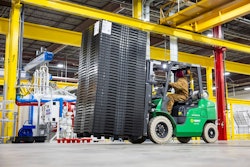
Are you prepared for the future of warehouse management? And, what is a smart warehouse exactly?
Simply put, it’s a warehouse that leverages advanced technologies to optimize operations. Experts project the smart warehousing market will grow more than 14% annually through the end of the decade, indicating that many distributors are looking to modernize. Those who aren’t risk falling behind.
As savvy business leaders target opportunities to innovate and gain a competitive advantage, many see how a smart warehousing strategy can optimize workflows and maximize success. Think of a warehouse management system (WMS) as the foundation that can transform your warehouse into a future-proofed operation where every item is tracked precisely, labor efficiency is elevated, and mistakes are minimized. With a WMS, businesses can achieve higher shipping accuracy, better inventory control, and improved customer satisfaction.
Overlooking a WMS investment means a drag on a more profitable operation. For those forward-thinking business leaders looking to introduce smart warehousing processes to boost the bottom line, a WMS is essential. Here are seven crucial benefits that it can deliver.
1. Improved inventory tracking and visibility
Ask yourself: How would you rate your inventory control? Are warehouse employees able to find items easily? Or are they spending too much time searching for products?
Introducing a warehouse management system is an excellent way to increase inventory visibility and tracking accuracy, making it easier to locate items and reduce inadvertent overstocking or stockouts. It integrates seamlessly with material handling equipment to streamline labor and enables more timely purchasing for your warehouse to help your business realize sales growth.
2. Enhanced employee management and performance insight
You probably know the size of your payroll, but where exactly are those hours being spent? How easily are you able to onboard and make new employees productive? Do you have visibility into employee efficiency and have you established incentives that are effective in driving employee performance?
A WMS strengthens employees’ performance by simplifying onboarding and tracking employee metrics. Warehouse managers can monitor user activity, tasks, and scans in real time, empowering them to identify top performers and those who have room to improve. These insights are also valuable when it comes to setting stronger KPI benchmarks and decreasing staffing costs.
3. Reduced operating expenses, driving cost savings
Mistakes cost money and negatively impact profits, as wrong items or quantities lead to shipping errors that are woeful to manage. A WMS sharply reduces these mistakes and lowers operating expenses by leveraging automation to lessen picking and shipping errors. This increased efficiency allows warehouses to switch to cycle counting instead of having to conduct full physical inventory, providing huge time-management gains. A WMS can also optimize inventory placement by employing slotting to accelerate picking and shipping speeds, with products moving quickly through the warehouse and on to customers.
4. Strengthened customer and supplier relationships
A healthy business is built on strong customer and partner relationships. A WMS fortifies these relationships by enabling better inventory control, accurate data on stock levels, and faster communication with suppliers. These capabilities prevent the errors and stockouts that customers hate while supporting sales growth through opportunities like e-commerce fulfillment. They can also heighten customer retention by driving greater confidence in your warehouse operation.
5. Regulatory compliance alignment
Compliance is not an area with which to gamble. It’s imperative to ensure your warehouse meets appropriate regulatory safety requirements to allow for effective operations and a safe, optimal workplace, as well as to reduce the risk of financial penalties.
A WMS can automatically create shipping documents and provide accurate tracking, auditing, and reporting of all items shipped and received. Furthermore, it can help maintain FIFO warehousing (first in-first out) and appropriate stock rotation to reduce product obsolescence (such as removing expired food or medicinal items). These capabilities streamline recall management to ensure the safe and secure distribution of goods.
6. Data-informed decisions
Like Sherlock Holmes famously said in A Study in Scarlet, “It is a capital mistake to theorize before one has data,” and the same rings true for warehouses that operate without accurate data. Good data can reveal patterns and trends that inform more strategic decision-making.
The right bolt-on WMS and an enterprise resource planning (ERP) system uniquely integrate to enhance core business processes. They show warehouse managers which decisions to prioritize that affect their business most, such as with company expenses and adjustments. For instance, what costs are associated with each warehouse work-type, such as receiving, putaway, picking or shipping? Do corrective measures need to be taken? Additionally, audit trails offer a real-time view of orders in progress that can be used to coordinate carrier pickup schedules, increasing transparency and fine-tuning order delivery.
7. Poised for scalability
As any business leader knows, consumer demand fluctuates. If there is a sudden spike or drop in demand, can your business respond quickly to satisfy your customers?
A WMS plays a crucial role in meeting demand surges and scaling accordingly.
While we can make educated market projections, no one knows what lies ahead. Ultimately, the trick is to seize opportunities when they emerge and arm your company with the right people, processes, and technology for sustained success in an ever-changing business climate. A smart warehousing strategy begins with a WMS investment that drives efficiencies and scalability. Don’t let postponing a WMS investment be part of your legacy. Doing so means missing out on achieving a competitive advantage that could take your business to whole new heights.



















